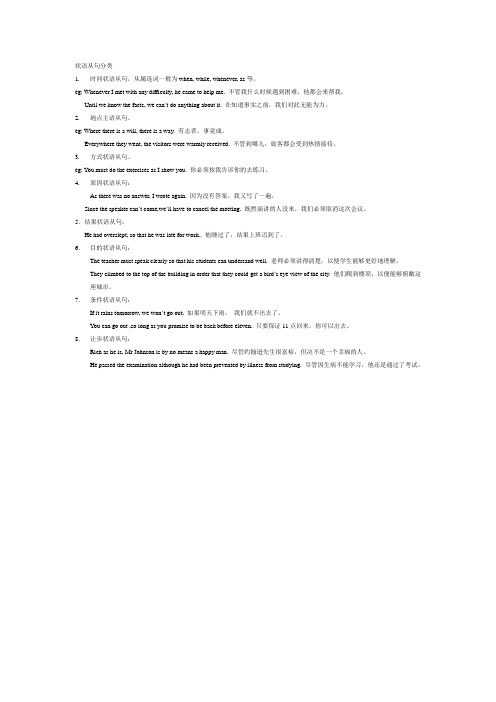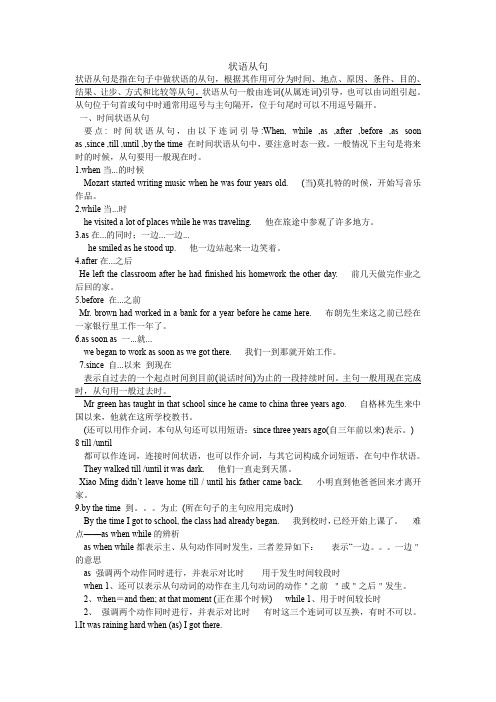从属连词-目的状语从句和时间状语从句
- 格式:pptx
- 大小:350.72 KB
- 文档页数:86

英语中的九大状语从句状语从句在主从复合句中修饰主句中的动词、形容词或副词等,按意义可以分为时间、地点、原因、目的、结果、条件、方式、比较、让步等状语从句。
一.时间状语从句。
通常由从属连词when, whenever, as, while, before, after, as soon as, till, until, since, once (一旦), hardly……when…, no sooner…….than…; 等引导。
例如:The cyclist started just as the lights changed to green.Whenever we met with difficulties , they cam to help us.He didn’t leave his office until he had finished the day’s work.应注意的问题1.在时间状语从句中,通常要用动词的一般现在时态表示一般将来时态,用一般过去时态表示过去将来时态。
但when 引导一般疑问句或名词性从句时不受上述语法规则的限制,因此,应该加以区分。
例如:When China will enter WTO depends on the bilateral (双边的)joint efforts.Once you understand the rules of the game, you’ll enjoy it.2.when , while, as 的不同用法。
一般说来,当主、从句的动作是同时发生的事,三者可以换用。
when 既可以引导一个持续动作,也可以引导一个短暂动作,可用于主句和从句动作同时发生或从句动作先于主句动作;while 引导的动作必须是持续性的,强调主句和从句的动作同时发生,往往侧重主句和从句动作的对比;as 用于引导“在某行为的继续中发生某事”的“继续之行为”,所以多与过去进行时连用,翻译成“一边……一边……”或者表示动作的变化,翻译成“随着……”。

状语从句知识点详解(初中英语专项复习)状语从句的概念: 用一个句子作状语来修饰动词和形容词,以表明动作发生或状态存在的时间、地点、原因等,这个句子就叫做状语从句。
状语从句的分类:状语从句共分为九大类,包括:时间、地点、原因、条件、让步、目的、结果、方式、比较状语从句。
下面分别讲解:一、时间状语从句概念:用来表示时间的状语从句,由when, while, as, till, until,before, after, since等引导。
由于时间状语从句的引导词所表示的意思并非一致,不同引导词表达不同的时间,它们在句子中对应的时态、语态等也有所不同。
例如:when /while引导的时间状语从句when引导的从句的谓语动词通常是瞬间动词,也可以是延续性动词。
从句动作可与主语动作通常先后发生也可同时发生。
I was writing when my sister came back.( come是瞬间动词,只能用when引导,不能用while)He often wrote me when/while he studied in Shanghai International Studies University.( study 是延续性动词,while可代替when)While my mother was cooking , I was playing chess with dad. (cook是延续性的动词,cook和play同时发生)I like playing chess while my sister likes reading stories.我喜欢下棋,而我姐姐喜欢看小说。
(while表示对比)when和while的区别还有:while引导的时间状语从句多用于进行时态,而when引导的时间状语从句多用于一般时态。
While we were playing games, our headmaster called me .我们正在做游戏的时候,校长叫我了。

状语从句分类1.时间状语从句,从属连词一般为when, while, whenever, as等。
eg: Whenever I met with any difficulty, he came to help me. 不管我什么时候遇到困难,他都会来帮我。
Until we know the facts, we can’t do anything about it. 在知道事实之前,我们对此无能为力。
2.地点主语从句。
eg: Where there is a will, there is a way. 有志者,事竟成。
Everywhere they went, the visitors were warmly received. 不管到哪儿,旅客都会受到热情接待。
3.方式状语从句。
eg: You must do the exercises as I show you. 你必须按我告诉你的去练习。
4.原因状语从句:As there was no answer, I wrote again. 因为没有答案,我又写了一遍。
Since the speaker can’t come,we’ll have to cancel the meeting. 既然演讲的人没来,我们必须取消这次会议。
5.结果状语从句:He had overslept, so that he was late for work.. 他睡过了,结果上班迟到了。
6.目的状语从句:The teacher must speak clearly so that his students can undersand well. 老师必须讲得清楚,以便学生能够更好地理解。
They climbed to the top of the building in order that they could get a bird’s eye view of the city. 他们爬到楼顶,以便能够俯瞰这座城市。


状语从句状语从句是指在句子中做状语的从句,根据其作用可分为时间、地点、原因、条件、目的、结果、让步、方式和比较等从句。
状语从句一般由连词(从属连词)引导,也可以由词组引起。
从句位于句首或句中时通常用逗号与主句隔开,位于句尾时可以不用逗号隔开。
一、时间状语从句要点: 时间状语从句,由以下连词引导:When, while ,as ,after ,before ,as soon as ,since ,till ,until ,by the time 在时间状语从句中,要注意时态一致。
一般情况下主句是将来时的时候,从句要用一般现在时。
1.when当...的时候Mozart started writing music when he was four years old. (当)莫扎特的时候,开始写音乐作品。
2.while当...时he visited a lot of places while he was traveling. 他在旅途中参观了许多地方。
3.as在...的同时;一边...一边...he smiled as he stood up. 他一边站起来一边笑着。
4.after在...之后He left the classroom after he had finished his homework the other day. 前几天做完作业之后回的家。
5.before 在...之前Mr. brown had worked in a bank for a year before he came here. 布朗先生来这之前已经在一家银行里工作一年了。
6.as soon as 一...就...we began to work as soon as we got there. 我们一到那就开始工作。
7.since 自...以来到现在表示自过去的一个起点时间到目前(说话时间)为止的一段持续时间。
主句一般用现在完成时,从句用一般过去时。

状语从句讲解状语从句由从属连词(subordinating conjunctions)引导。
注意状语从句与主句之间的逻辑关系,选择正确的连词;有些连词能引导多种状语从句。
一、时间状语从句引导时间状语从句的从属连词主要有:after,as,before,once, since,till,until,when,whenever,while,as soon as;另外有些词如:immediately(立刻),directly(直接的),instantly(立即地)用于as soon as 意义时,有些名词词组如the moment(片刻),the instant(立即的),the minute,the day,the year,every time,next time,each time 等也用来引导时间状语从句:The mother didn't go to bed until her little daughter returned home last night. 昨晚母亲等到她的小女儿回家才睡觉。
I'll explain it to you immediately I've finished reading the letter. 我读完信立刻给你解释。
You see the lightning __________it happens,but you hear the thunder later.A)the instant(立即) B)for an instantC)on the instant(马上) D)in an instant(马上)闪电一发生,你立刻就能看到它,但雷声,你迟一点才能听到它。
(B4,1997.1-38,A对。
)No sooner ... than 和hardly/scarcely/barely ... when 也用来引导状语从句,意思是“一……就……”;如果将no sooner,hardly, scarcely,barely放在句首,就用倒装结构。
各种从句的连接词20191121学习笔记状语从句1.时间状语从句常见的连接词有:when, while, as, before, after, until 或者till, not…until和since2.地点状语从句常见的连接词有:where, wherever 或者wverywhere3.原因状语从句常见的连接词有:because, due to, thanks to, as a result of, in that和now that4.目的状语从句常见的连接词有:so that, in order that, 和in case5.结果状语从句常见的连接词有:so…that或者such…that. So要保留,但是that可以省略。
这里要注意so和such的用法差别So的结构是so加形容词,加不定冠词a/an,加名词再加that.e.g. It was so hot a day that crops wilted.天气太热,庄稼都枯萎了。
Such的结构是such加a/an,加形容词,加名词再加that.e.g. It was such a hot day that crops wilted.注意了吗:so hot a day和such a hot day6.条件状语从句常见的连接词有:if, unless, as long as, 和on condition that7.让步状语从句常见的连接词有:though, although, even if, even though和as.注:as引导让步状语从句时,在表示“虽然”的时候,句子要用倒装结构。
e.g. Hard as she works, she makes very little progress.虽然她很努力,但是没怎么进步。
8.比较状语从句除了常见的as和than,比较状语从句还有其他特殊的引导词,比如the more…the more…和no more…than9.方式状语从句常见的连接词有:as if, as though和in the way that或者the waye.g. He looks as if he is angry.他看起来好像生气了。
状语从句常用引导词归纳引导状语从句的词语叫从属连词。
不同作用的状语从句通常由不同的从属连词来引导。
如:1. 引导时间状语从句的从属连词主要有when, while, as, whenever, before, after, since, until, till, as soon as, the moment, the minute, the second, the instant, immediately, directly, instantly, once等。
2. 引导条件状语从句的从属连词主要有if, unless, as [so] long as, in case 等。
3. 引导目的状语从句的从属连词主要有 in order that, so that, in case, for fear等。
4. 引导结果状语从句的从属连词主要有so that, so…that, such…that等。
5. 引导原因状语从句的从属连词主要有because, as, since, seeing (that), now (that), considering (that) 等。
6. 引导让步状语从句的从属连词主要有although, though, even though, even if, while, however, whatever, whoever, whenever, wherever等。
7. 引导方式状语从句的从属连词主要有as, like, as if, as though, the way等。
8. 引导地点状语从句的从属连词主要有where, wherever, everywhere等。
9. 引导比较状语从句的从属连词主要有than和as…as。
as long as和so long as引导条件状语从句的区别as long as 和so long as 均可表示“只要”,用于引导条件状语从句,两者没什么区别。
英语八类状语从句的用法归纳一、概说状语从句即指在主从复合句用作状语的从句。
按照其意义,状语从句可分为时间状语从句、地点状语从句、原因状语从句、目的状语从句、结果状语从句、条件状语从句、让步状语从句等。
状语从句是高中英语学习中的一个语法重点,也是历年高考重点考查的内容之一。
学习状语从句主要应注意引导状语从句的从属连词的用法与区别,以及从属连词在一定的语言环境中的意义与用法。
二、时间状语从句1.引导时间状语从句的从属连词很多,常见的有before, after, when, while, as, since, till, until, as soon as 等。
2.表示“当…时候”的while, when, as 的用法区别是:while从句中的谓语动词必须是延续性动词;表示带有规律性的“每当”或当主、从句谓语动词的动作发生有先后时,只能用when;当表示“一边…一边…”或“随着”时,只能用as。
另外,用于此义的as 所引导的时间状语从句谓语只能是动作动词,不能是状态动词。
如下面一道高考题的答案是B 而不能是A:“I’m going to the post office.” “_____ you’re there, can you get me some stamps?”A. AsB. WhileC. BecauseD. If3.until 在肯定句中通常只连用延续性动词,表示相应动作结束的时间;在否定句中通常连用非延续性动词,表示相应动作开始的时间,意为“直到…才”。
如:He waited until she was about to leave. 他等着一直到她准备离开。
I did not begin to work till he had gone. 他走了后我才开始工作。
4.表示“一…就”除用as soon as 外,还可用the minute, the second, the instant, immediately, directly, i nstantly, no sooner…t han, hardly…w hen 等。
高中英语语法:状语从句知识点状语从句(adverbial clause)在句中作状语,可修饰主句中的动词、形容词和副词等。
状语从句由从属连词引导。
状语从句可放在句首或句末。
放在句首时,从句后面常用逗号;放在句末时,从句前面往往不用逗号。
状语从句根据它们的含义分为时间、地点、原因、目的、结果、方式、让步、条件、比较等九种。
一、时间状语从句1、while, when, whenever和as的用法比较(1)while常表示一段较长的时间或一个过程,强调主句的动词和从句的动词所表示的动作或状态是同时发生的。
它不能表示一时性或短暂的动作。
Don't talk so loud while( as) others are working.别人工作时,请勿大声说话。
(2)when引导的时间状语从句,可指时间的一点,也可以指一段时间,从句的谓语动词可用终止性动词,也可用持续性动词。
when引导的从句表示的具体的时间,从句的动作和主句的动作可以同时,也可以先于主句的动作。
Whenever指任何一个不具体的时间。
It was raining when we arrived. 我们到达时,天正下着雨。
(动作同时,指时间点)When you read the poem a second time, the meaning will become clearer to you.当你再读一遍这首诗,你就更清晰它的含意。
(动作有先后,指时间点,不能用while)Come whenever you like. 你爱什么时候来就什么时候来。
(3)as用as时主句和从句的动作往往同时发生,具有延伸意义,一般同延续性动词连用,有时可译作“一边…一边…”。
As time went on, his theory proved to be correct.随着时间的推移,他的理论被证明是正确的。
As(when)he finished the speech, the audience burst into applause.他讲话结束的时候,听众掌声雷动。